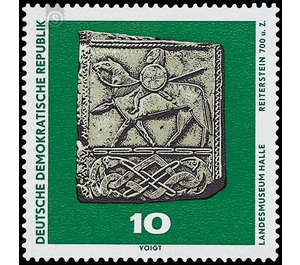Archaeological finds in the GDR - Germany / German Democratic Republic 1970 - 10 Pfennig
Theme: Animals
| Country | Germany / German Democratic Republic |
| Issue Date | 1970 |
| Face Value | 10.00 |
| Color | green |
| Perforation | K 13 |
| Printing Type | Photogravure |
| Stamp Type | Postage stamp |
| Item Type | Stamp |
| Chronological Issue Number | 1295 |
| Chronological Chapter | GER-DDR |
| SID | 995634 |
| In 33 Wishlists | |
Archaeological finds in the GDR The Ministry of Posts and Telecommunications of the German Democratic Republic issues four multi-colored special postage stamps with illustrations of archaeological finds in the GDR from the State Museum of Prehistory in Halle. Archaeological research in the German Democratic Republic has achieved many new and sometimes surprising results in recent years, which provide information about the life and activities of prehistoric man on the soil of the GDR. The GDR is one of the few states in the world in which the prehistoric and protohistorical landlords enjoy legal protection (Ordinance on the Protection and Preservation of Prehistoric and Early Historical Landscapes, 1954). One of the leading archaeological research centers in the GDR is the Landesmuseum für Vorgeschichte Halle (Saale), which enjoys a reputation far beyond the borders of our country and maintains international connections with similar research institutions on all continents. From the rich find of the Landesmuseum for prehistory Halle four objects were selected as motives for stamps, which are of special cultural-historical meaning. 10 Pfennig value Reiterstein 700 u. Ztr. The Reiterstein von Hornhausen, Oschersleben district, has found worldwide distribution in archaeological and art history publications. At the center of the artistic composition is the figure of a defensive rider executed in a bas-relief. Equipped with shield, lance and sword, he sits on an oversized horse. The basis for the presentation is a meander-folded snake with its head hanging down to the right. The combination of rider and ornamental snake gives an indication of the art-historical origin: It is originally the early Christian motif of the knight St. George, who defeated the dragon, the symbol of evil. In the pagan transformation, the dragon stepped into the background; he degenerated into an ornamental component. The rider reflects the idea of death of the early, not yet Christianized feudal society: also the survival in the hereafter should be done on a knightly basis. - There is another ornamental composition below the meandering serpent: two band-shaped animals with long snouts in opposite directions. The design took place in the style of the Scandinavian animal style of the 7th century of our era.


